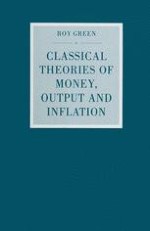
1992 | OriginalPaper | Buchkapitel
Theory of the Fiduciary System
verfasst von : Roy Green
Erschienen in: Classical Theories of Money, Output and Inflation
Verlag: Palgrave Macmillan UK
Aktivieren Sie unsere intelligente Suche, um passende Fachinhalte oder Patente zu finden.
Wählen Sie Textabschnitte aus um mit Künstlicher Intelligenz passenden Patente zu finden. powered by
Markieren Sie Textabschnitte, um KI-gestützt weitere passende Inhalte zu finden. powered by
In the previous chapter, I have examined the development of eighteenth century monetary analysis. The period began with the inflationary collapse of Law’s System and ended with Smith’s succinct presentation of classical doctrine in the Wealth of Nations. The suspension of cash payments by the Bank of England in 1797 following the outbreak of the Napoleonic war opened a new phase of price inflation — or, more precisely, several distinct phases — and rekindled theoretical debate. This inflation was accompanied by a rise in the market price of bullion over its mint price, i.e., a depreciation of paper currency in terms of the monetary standard, a phenomenon which could not have existed when convertibility was enforced by law. The central problem was to explain the appearance of a premium on bullion, and to find a principle whose practical implementation would restore and maintain ‘economic convertibility’, thus ensuring that the bank notes conformed to the laws of metallic currency I have already outlined. It was not surprising, therefore, that the first decade of the nineteenth century should have been, in Marx’s words, ‘hardly more prolific of war bulletins than of monetary theories’ (1859, p. 81).